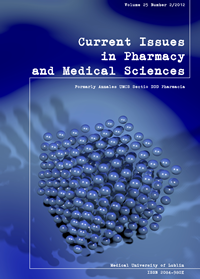Plasma magnesium and calcium concentrations and selected biochemical parameters in patients with type 2 diabetes mellitus
DOI:
https://doi.org/10.12923/j.2084-980X/25.2/a.02Keywords:
diabetes mellitus type 2, magnesium, calcium, lipid profileAbstract
Magnesium and calcium are known to play an important role in carbohydrate metabolism. These elements are also involved in secretion, binding, and activity of insulin. It is well-established that plasma magnesium and calcium levels in patients with diabetes mellitus are somewhat decreased. Additionally, chronic magnesium and calcium deficiency have been associated with the development of insulin resistance. Type 2 diabetes is characterized by increasing concentrations of triglycerides, total cholesterol, LDL-cholesterol and lowering of the HDL-cholesterol. Hypertriglyceridemia is often the first metabolic manifestation of insulin resistance. The purpose of this study was to determine the correlation between plasma magnesium and calcium concentrations and plasma lipids, blood glucose and glycosylated hemoglobin in type 2 diabetic patients. Magnesium and calcium concentration was determined with the colorimetric method. Lipid profile (total, HDL, LDL cholesterol, triglycerides), glycosylated hemoglobin A (HbA1c) and glucose were measured using standard methods. The plasma concentrations of glucose, HbA1c, LDL-cholesterol and triglycerides in diabetic patients were found to be significantly higher than those in the control group. The concentrations of calcium, magnesium and HDL-cholesterol were statistically lower in diabetic people in comparison to healthy individuals. In diabetic patients, a weak negative correlation was found between plasma magnesium and total cholesterol as well as between plasma magnesium and triglycerides. Positive correlations were demonstrated between plasma calcium and glycosylated hemoglobin.
References
1. Abou-Seif M., Youssef A.A.: Evaluoation of some biochemical changes in diabetes patients. Clin Chim Acta 346, 161, 2004.
2. Barbagallo M. et al.: Role of magnesium in insulin action, diabetes and cardio-metabolic syndrome X. Mol Aspects Med 24, 39, 2003.
3. Chaudhary D.P., Sharma R., Bansal D.D.: Implications of magnesium deficiency in type 2 diabetes: A Review. Biol Trace Elem Res 134, 119, 2010.
4. Cigolini M. et al.: Serum 25-hydroxyvitamin D3 concentrations and prevalence of cardiovascular disease among type 2 diabetic patients. Diabetes Care 29, 722, 2006.
5. Duncan B.B. et al.: Low-grade systemic inflammation and the development of type 2 diabetes: the atherosclerosis risk in communities study. Diabetes 52, 1799, 2003.
6. Habib S.S., Aslam M.: Lipids and lipoprotein(a) concentrations in Pakistani patients with type 2 diabetes mellitus. Diabetes Obes Metab 6, 338, 2004.
7. Hofbauer L.C. et al.: Osteoporosis in patients with diabetes mellitus. J Bone Miner Res 22, 1317, 2007.
8. Hu F.B. et al.: Inflammatory markers and risk of developing type 2 diabetes in women. Diabetes 53, 693, 2004.
9. Kareem I. et al.: Study of magnesium, glycosylated hemoglobin and lipid profile in diabetic retinopathy. Indian J Clin Biochem 19, 124, 2004.
10. Lal J. et al.: Effects of oral magnesium supplementation on the lipid profile and blood glucose of patients with type 2 diabetes mellitus. J Assoc Physicians India 51, 37, 2003.
11. Levy J.: Abnormal cell calcium homeostasis in type 2 diabetes mellitus. Endocrine 10, 1, 1999.
12. Liu Z.C., Ho S.: The association of serum C-reactive protein, uric acid and magnesium with insulin resistance in Chinese postmenopausal women with prediabetes or early untreated diabetes. Maturitas 70, 176, 2011.
13. McCarty M.F., Thomas C.A.: PTH excess may promote weight gain by impeding catecholamine-induced lipolysis-implications for the impact of calcium, vitamin D, and alcohol on body weight. Med Hypotheses 61, 535, 2003.
14. Mooren F.C. et al.: Oral magnesium supplementation reduces insulin resistance in non-diabetic subjects – a double-blind, placebo-controlled, randomized trial. Diabetes Obes Metab 13, 281, 2011.
15. Nasri H.: Lipids in association with serum magnesium in diabetes mellitus patients. Acta Angiol 124, 149, 2006.
16. Nicodemus K.K., Folsom A.R.: Iowa Women's Health Study 2001. Type 1 and type 2 diabetes and incident hip fractures in postmenopausal women. Diabetes Care 24, 1192, 2001.
17. Ojuka E.O.: Role of calcium and AMP kinase in the regulation of mitochondrial biogenesis and GLUT4 levels in muscle. Proc Nutr Soc 63, 275, 2004.
18. Paolisso G., Barbagallo M.: Hypertension, diabetes mellitus and insulin resistance. The role of intracellular magnesium. Am J Hypertens 10, 346, 1997.
19. Pittas A.G. et al.: The role of vitamin D and calcium in type 2 diabetes. A systematic review and meta-analysis. JCEM 92, 2017, 2007.
20. Pittas A.G. et al.: Vitamin D and calcium intake in relation to type 2 diabetes in women. Diabetes Care 29, 650, 2006.
21. Pradhan A.D. et al.: C-reactive protein, interleukin 6, and risk of developing type 2 diabetes mellitus. JAMA 286, 327, 2001.
22. Przybylik-Mazurek E. et al.: Zaburzenia lipidowe w przebiegu cukrzycy typu 2 a współwystępowanie nadciśnienia tętniczego, choroby niedokrwiennej serca i otyłości. Endokrynol Otyłość 2, 86, 2006.
23. Rodriguez-Moran M., Guerrero-Romero F.: Oral magnesium supplementation improves insulin sensitivity and metabolic control in type-II diabetic subject. Diabetes Care 26, 1147, 2003.
24. Roehrich M.E. et al.: Insulin-secreting beta-cell dysfunction induced by human lipoprotein. J Biol Chem 278, 18368, 2003.
25. Rutti S. et al.: A low and high density lipoprotein modulate function, apoptosis and proliferation of primary human and murine pancreatic beta cells. Endocrinology 150, 4521, 2009.
26. Sales C.H., Pedrosa L: Magnesium and diabetes mellitus: Their relation. Clin Nutr 25, 554, 2006.
27. Sales C.H. et al.: Influence of magnesium status and magnesium intake on the blood glucose control in patients with type 2 diabetes. Clin Nutr 30, 359, 2011.
28. Song Y.M., Sheu W.H.H., Lee W.J.: Acute biochemical variations induced by calcium citrate and calcium carbonate in Type 2 diabetic patients. Impaired calcium absorption in Type 2 diabetic patients with prolonged gastric emptying time. J Diabetes Complications 15, 97, 2001.
29. Wright D.C. et al.: Ca2+ and AMPK both mediate stimulation of glucose transport by muscle contractions. Diabetes 53, 330, 2004.
30. Zemel M.B. et al.: Regulation of adiposity by dietary calcium. FASEB J 14, 1132, 2000.
Downloads
Published
Issue
Section
License
Copyright (c) 2012 Authors

This work is licensed under a Creative Commons Attribution-NonCommercial-NoDerivatives 3.0 Unported License.


